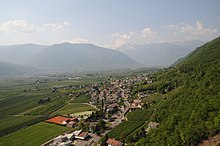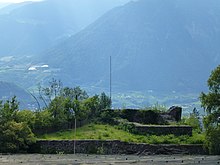Burgstall (South Tyrol)
| Burgstall | |
|---|---|
| (Italian: Postal ) | |
| coat of arms | map |
| State : | Italy |
| Region : | Trentino-South Tyrol |
| Province : | Bolzano - South Tyrol |
| District community : | Burgrave Office |
|
Inhabitants : (VZ 2011 / 31.12.2019) |
1,763 / 1,903 |
|
Language groups : (according to 2011 census ) |
76.61% German 22.78% Italian 0.61% Ladin |
| Coordinates | 46 ° 36 ' N , 11 ° 12' E |
| Altitude : | 256– 1060 m slm (center: 270 m slm ) |
| Surface: | 6.7 km² |
| Permanent settlement area: | 3.3 km² |
| Neighboring municipalities: | Gargazon , Lana , Meran , Mölten , Verano |
| Postal code : | 39014 |
| Area code : | 0473 |
| ISTAT number: | 021066 |
| Tax number: | 82003230214 |
| Mayor (2015): | Othmar Unterkofler ( SVP ) |
Burgstall ( Italian Postal ) is an Italian municipality with 1903 inhabitants (as of December 31, 2019) in South Tyrol . Burgstall borders Gargazon in the south, Merano in the north, Lana in the west and Verano and Mölten in the east .
The population lives mainly from agriculture, fruit growing, tourism and services.
geography
Burgstall is located in the Burggrafenamt in the Adige Valley between Merano and Bozen . The municipality extends on the orographic left , eastern side of the valley and has a size of almost 7 km², with about half of the areas being agricultural green or forest. The center of the village is located at around 270 m above the valley floor . In the east, the municipality rises on the slopes of the Tschögglberg up to 1000 m ; in the west it ends at the Adige .
history
Burgstall was built under the protection of Volkmar von Burgstall's castle, which is now only a ruin. The church and much later the school building were built around them. The historical buildings are on the slope because the valley floor was still swampy and inaccessible in the Middle Ages. Today the village center is being moved more and more to the bottom of the valley due to the more favorable conditions. The drainage of the valley floor took place with the regulation of the Etsch around 1880 and in the following years with the construction of drainage ditches by the Passer-Eisack estuary bonus consortium, whose members are the landowners (farmers). Today, fruit growers from Burgstall and the neighboring communities cultivate these areas in the valley floor almost entirely as apple orchards.
Burgstall belonged to the judicial district of Merano until the end of the First World War and was part of the district of Merano .
economy
In the valley floor, where the soil is moist and rich in nutrients, mainly apples are grown. On the higher slopes, grapevines are grown, which tolerate the somewhat poorer soil better than the fruit trees. The dairy industry was completely replaced by fruit growing in the 1980s. By designating an area for an industrial zone, an attractive source of income could be created for the population in the village.
The best-known company in Burgstall is Dr. Schär GmbH, which produces gluten-free food.
traffic
The main road, which runs through the center of the village, has been significantly relieved by the construction of the Merano - Bozen ( MeBo ) expressway , which largely shielded the population from the noise and exhaust gases. As a result, Burgstall is in a location that is remote from heavy traffic and heavy traffic, but still has good transport links. Meran can be reached within 10 minutes and Bolzano in 15 minutes. The Lana-Burgstall station on the Bozen – Merano railway line, which is mainly used by commuters, is only about 10 minutes' walk from the village. Three public bus routes run through Burgstall, offering quick connections to Lana, Merano and Bozen. The Vöran cable car also connects the village with the mountain community of Vöran
tourism
In 2001, two years after the opening of the Merano - Bozen expressway, work began on dismantling the state road. This made way for a cycle path that now connects Burgstall to the South Tyrol-wide cycle network. In 2007, work began on expanding the cycle path to Sinich. In Burgstall there is a biotope that remained after the bottom of the valley was drained and the floodplains were destroyed. On the slope of the Tschöggelberg, the historic center with the Holy Cross Church can be visited. There is also a natural history museum. Extensive tours can be undertaken by bike into the Passeier Valley and the Unterland. The Verano cable car can be used to quickly reach Verano, where hikers can enjoy a variety of hiking options. Verano can also be reached on a path.
population
At the end of 2011, almost 1,800 people lived in Burgstall. Over three quarters of the population are German-speaking, the Italian-speaking share is just over a fifth. There is a kindergarten in the community for both language groups. The primary school students of the German language group attend the school in the village.
Community activities
There are many active associations in Burgstall, which work primarily on a voluntary basis. The clubs with the largest number of members are the music band and the volunteer fire brigade . In 2002 the fire station with an attached rehearsal room for the band was rebuilt. In 2002, a village master plan was set up in cooperation with many community members, which should bring the ideas for the future of the community and citizens under one roof. The strongest party in Burgstall is the South Tyrolean People's Party . Burgstall has its own village magazine (“Volkmar”), which appears four times a year.
Attractions
- Burgstall parish church
- Burgstaller Auen biotope
- Sunnseitn-Steig
politics
Mayor since 1952:
- Josef Burger: 1952–1960
- Franz Gruber: 1960–1980
- Alois Schenk: 1980-1995
- Martin Ganthaler: 1995-2010
- Othmar Unterkofler: since 2010
Web links
- Burgstall municipality
- Entry in the Tirol Atlas of the Institute for Geography at the University of Innsbruck
- Landscape plan of the municipality of Burgstall . Office for Landscape Ecology, Autonomous Province of Bolzano - South Tyrol (PDF file)
- History-Tyrol: Burgstall
Individual evidence
- ^ Oswald Trapp : Tiroler Burgenbuch. Volume II: Burgrave Office . Athesia publishing house, Bozen 1980, pp. 222-224.
- ↑ The mayors of the South Tyrolean municipalities since 1952. (PDF; 15 MB) In: Festschrift 50 Years of the South Tyrolean Association of Municipalities 1954–2004. Association of South Tyrolean municipalities, pp. 139–159 , accessed on November 16, 2015 .





